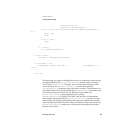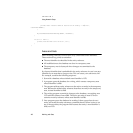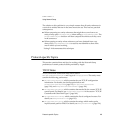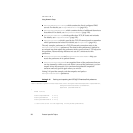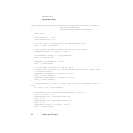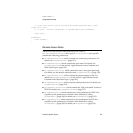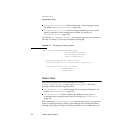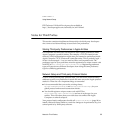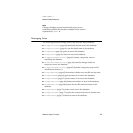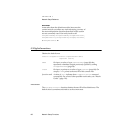
CHAPTER 2
Using Network Setup
Protocol-specific Topics 53
// If the cursor doesn’t stop at the end of the packed preference data, a data
format error occurs.
if ( (cursor - ((UInt8 *) packedPref)) != packedPrefSize) goto prefDataErr;
return noErr;
prefDataErr:
return paramErr;
}
Remote Access Notes 2
A Remote Access network connection entity has a class of
kOTCfgClassNetworkConnection and a type of kOTCfgTypeRemote and typically
contains the following preferences:
■ kOTCfgRemoteConnectPref, which contains core connection preferences. For
details, see OTCfgRemoteConnect (page 127).
■ kOTCfgRemoteUserPref, which contains the user name. For details, see
OTCfgRemoteUserPref in the section “Apple Remote Access Constants and
Other Data Types” (page 163).
■ kOTCfgRemotePasswordPref, which contains the user’s encrypted password.
For details, see the sample code below and OTCfgRemotePassword (page 135).
■ kOTCfgRemoteAddressPref, which contains the phone number to dial. For
details, see OTCfgRemoteAddressPref in the section “Apple Remote Access
Constants and Other Data Types” (page 163).
■ kOTCfgRemoteDialingPref, which contains redial preferences. For details, see
OTCfgRemoteDialing (page 131).
■ kOTCfgRemoteClientMiscPref, which controls the “dial on demand” feature of
IPCP. For details, see OTCfgRemoteClientMisc (page 127).
■ kOTCfgRemoteIPCPPref, which contains low-level preferences for IPCP. You
typically set this preference to a default value obtained by calling
OTCfgGetDefault (page 90). For details, see OTCfgRemoteIPCP (page 132).
■ kOTCfgRemoteLCPPref, which contains low-level preferences for LCP. You
typically set this preference to a default value obtained by calling
OTCfgGetDefault (page 90). For details, see OTCfgRemoteLCP (page 133).



